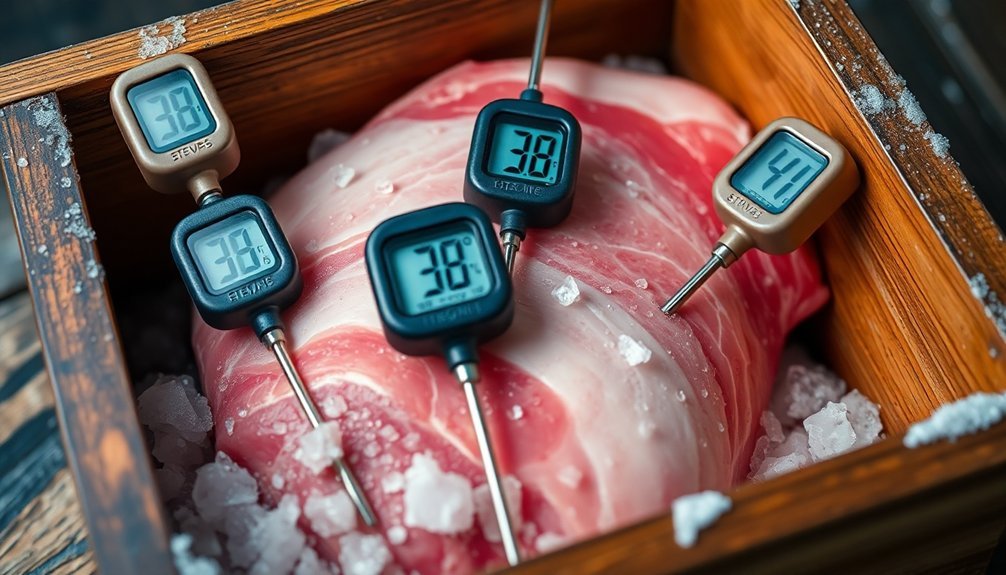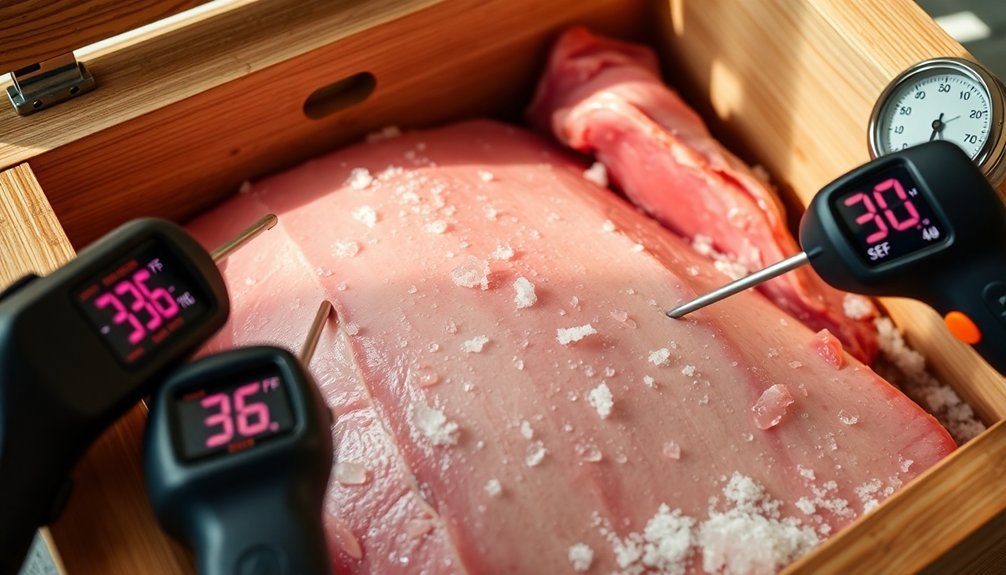Keep your salt box meat curing temperatures between 36-40°F (2-5°C) for safe, effective results. You'll want to monitor the temperature daily with a reliable thermometer, adjusting as needed to prevent harmful bacterial growth. Don't let humidity levels drop too low – maintain around 60% for proper curing while ensuring good airflow around the meat. These precise controls help achieve ideal salt penetration and prevent spoilage during the curing process, which typically takes about 7 days per inch of meat thickness. Mastering these temperature essentials will set you up for consistently successful curing projects.
Maintaining Cold Storage Temperatures

Before starting your meat curing journey, you'll need to nail down the right temperature control strategy. Your ideal curing temperature should stay between 36-40°F (2-5°C) when using nitrites, though some methods can tolerate up to 45°F (7°C).
You'll want to maintain these temperatures consistently to prevent bacterial growth and guarantee even curing throughout your meat. Don't let your storage temperatures fluctuate, as this can lead to uneven curing and potential spoilage. The cold winter months provide optimal conditions for successful meat curing.
If you're working with temperatures below freezing, remember to extend your curing time accordingly. You'll also need to monitor humidity levels, keeping them around 60-65% for best results.
Set up your curing space in a refrigerator or cool, well-ventilated area where you can hang the meat to guarantee proper airflow. Keep your storage area clean and sanitized to prevent cross-contamination.
It's smart to label your meats and track their progress throughout the curing process. Remember that proper temperature control isn't just about food safety – it directly affects how well your salt penetrates the meat and ultimately determines the quality of your final product.
Time and Temperature Balancing
Three key principles govern successful meat curing: time, temperature, and balance. You'll need to carefully monitor both the duration and temperature throughout the curing process to achieve ideal results.
Keep your curing temperatures between 36-40°F, as this range prevents bacterial growth while allowing proper enzyme development. For every inch of meat thickness, plan for approximately 7 days of curing time. Traditional butchers often use dry curing methods to preserve their meats, ensuring optimal flavor development.
To effectively balance time and temperature, you'll want to use a reliable thermometer and maintain detailed records of your curing process. If temperatures drop below freezing, remember to extend your curing time by adding those frozen days to your schedule. The perfect temperature for dry curing sits between 38-45°F, but you'll need to adjust based on your specific cut of meat.
- Monitor temperature daily using a calibrated thermometer
- Calculate curing time based on meat thickness (7 days per inch)
- Track start and end dates, adjusting for any temperature fluctuations
- Watch for signs of spoilage, including off-odors or unusual colors
- Store cured meat at 33-40°F after the curing process is complete
Pay close attention to temperature consistency, as fluctuations can lead to uneven curing or potential spoilage. If temperatures rise above 40°F, you risk bacterial growth and enzyme destruction.
Humidity and Temperature Controls

Proper temperature monitoring goes hand-in-hand with effective humidity control when curing meat.
You'll want to maintain temperatures between 36-40°F (2-5°C) when using nitrites, though some methods may call for slightly higher ranges of 50-60°F (8-15°C). Never let your curing chamber drop below freezing, as this can compromise the meat's quality. The controlled temperature helps ensure that the dry cure penetrates properly into the meat.
You'll need to keep humidity levels around 60%, which is considerably lower than typical commercial coolers.
Install your humidity controller at the meat's level, and place your humidifier at the bottom of the chamber. Don't forget to sterilize your curing space with diluted bleach before use to prevent unwanted bacterial growth.
Watch out for high humidity issues, which can cause sticky surfaces and unwanted mold growth.
You'll find it's more effective to focus on removing excess moisture rather than trying to heat the chamber. Use proper air circulation techniques, like hanging meat with cheesecloth or butcher's knots, and consider installing an exhaust fan if needed.
Remember that ambient conditions can affect your chamber's internal environment, so you'll need to monitor and adjust your controls continuously.
Frequently Asked Questions
How Do Temperature Fluctuations Affect the Color Development of Cured Meats?
Temperature fluctuations can disrupt your meat's color development by causing metmyoglobin formation, accelerating nitric oxide loss, and interfering with enzymatic reactions. You'll notice uneven coloring and premature fading in your cured meats.
Can Different Cuts of Meat Cure Effectively at Slightly Different Temperatures?
Yes, you'll find that different cuts can cure at varying temperatures within the 36-40°F range. Thicker, fattier cuts do better at cooler temperatures, while leaner, smaller cuts can handle slightly warmer temperatures.
Does Altitude Impact the Ideal Temperature Range for Curing Meats?
You don't need to worry about altitude when curing meats. It won't affect your ideal temperature range of 32-40°F. Just focus on maintaining consistent temperature and proper humidity levels in your curing space.
What Role Does Meat Thickness Play in Temperature Selection?
You'll need to adjust your curing temperature based on meat thickness. Thicker cuts require more stable temperatures to guarantee even salt penetration, while preventing surface drying before the interior's fully cured.
How Do Seasonal Temperature Changes Affect Traditional Outdoor Curing Methods?
You'll need to carefully monitor outdoor temperatures as seasonal changes directly impact curing times. Winter's cold helps initial curing, while summer's heat can spoil your meat, so you'll want to adjust your process accordingly.
In Summary
You've now learned the essential temperature tips for salt box meat curing. Keep your curing space between 36-40°F for ideal results, monitor the time-temperature relationship closely, and maintain proper humidity levels between 65-75%. By following these temperature guidelines, you'll prevent spoilage and achieve consistently well-cured meats. Remember, success in meat curing depends on your careful attention to these critical temperature controls.





Leave a Reply